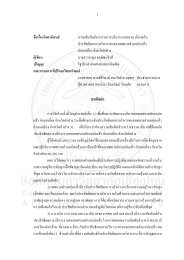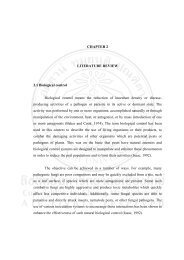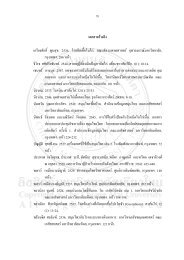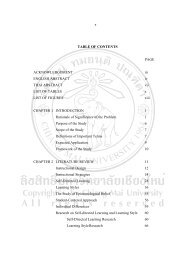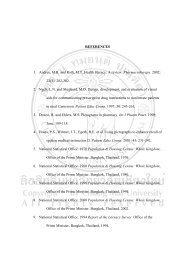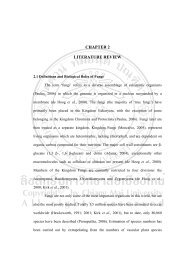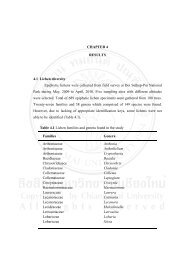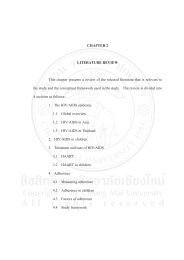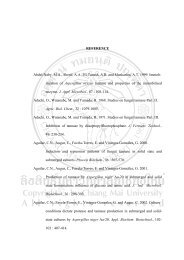CHAPTER II MATERIALS AND METHODS 2.1 Chemicals and ...
CHAPTER II MATERIALS AND METHODS 2.1 Chemicals and ...
CHAPTER II MATERIALS AND METHODS 2.1 Chemicals and ...
Create successful ePaper yourself
Turn your PDF publications into a flip-book with our unique Google optimized e-Paper software.
34<br />
<strong>2.1</strong>0.3 cDNA synthesis by reverse transcription<br />
Total RNA prepared in step <strong>2.1</strong>0.2 was primed with oligo-(dT)18 primer to<br />
synthesize first-str<strong>and</strong>ed complementary DNA using AMV reverse transcriptase<br />
(Fermentus), according to the manufacturer’s instructions. Briefly, The 20 µl reaction<br />
mixture contained 1 µg of extracted RNA, 0.5 µg of oligo-(dT)18, 1 mM dNTPs, 20<br />
unit of ribonuclease inhibitor, 200 units of reverse transcriptase, <strong>and</strong> adjusted volume<br />
to 20 µl with DEPC-treated water. The reaction mixture were incubated at94 o C for 5<br />
min, 42 o C for 1 h <strong>and</strong> then at 70 o<br />
C for 10 min. The extracted RNA was converted to<br />
cDNA in these processes.<br />
<strong>2.1</strong>0.4 PCR optimization<br />
The PCR condition of interested genes (VEGF <strong>and</strong> GAPDH) was optimized to<br />
yield the amplified products without any nonspecific byproduct. The annealing<br />
temperature was varied within the range from 58using a fixed number of<br />
PCR cycle at 30. Next, the optimum PCR cycle was analyzed by various of numbers<br />
PCR cycle from 15 to 33 cycles that could give the proportional PCR product relative<br />
to its original cDNA. The chosen PCR condition, the annealing temperature <strong>and</strong> the<br />
number of PCR cycle, was confirmed by 2-fold dilution series of cDNA template: 1x,<br />
0.5x, 0.25x, <strong>and</strong> 0.125x.<br />
The procedures <strong>and</strong> optimized protocols are as follows: The 10 µl reaction<br />
mixture contained 1.0 µg of cDNA, 1X buffer (10 mM Tris-HCl pH 9.0, 50 mM KCl<br />
<strong>and</strong>, 2.0 mM MgCl2),<br />
0.2 mM dNTPs, 2 units of Taq polymerase, <strong>and</strong> 0.2 µM of<br />
primers. Each reaction mixture was then placed on a Mastercycler gradient thermal<br />
cycler. The temperature profile was as follows: initial denaturation at 95 C for 5




